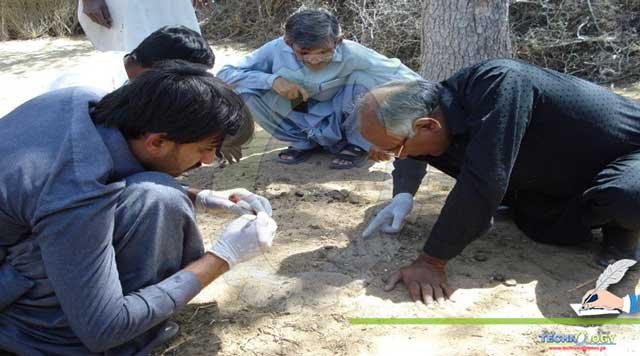During a research trip to Tharparkar, aimed at collection of livestock tics, Dr. Jhamandas, a veterinary officer posted at CVDL Mithi (now retired) said, “Sir, here you would find specific species of ticks, that remain hidden in the sand and can smell perspiration of a person sitting on sandy ground and would suck blood as quick as possible and run away”

Dr. Arijo and his team working in a village near Mithi Tharparkar
Un-believable “one of my team members replied. “Let us go and collect these ticks first” I said. And we all drove to a small village Malen Je Hor nearly 5 km away from Mithi. Everyone sat on the ground and start gazing the ground. It took 7 minutes when Samina and Badar shouted “Ticks”. They were coming off the ground and we started collecting them. I pulled my shalwar up to my knees with intention to see if these ticks come up on the legs and take a blood meal. Yes, they did.
Back in molecular parasitology laboratory of Sindh Agriculture University Tandojam, we prepared permanent mounts of ticks in Canada Balsm, and subjected them to taxonomies using microscope. They were Sand Tampons.
Sand tampon is ferocious soft tick (family Argasidae) ectoparasite with a leathery, integument and they belong to genus Ornithdorous, which are also commonly known as camel tick.
Morphology:-
- Leathery-mamillated integument
- Mouthparts recessed ventrally and not visible from above (except in larvae)
- Body margin rounded
- Supra-coxal fold
- Eyes are present.
- Female ticks are 10–13 mm and males 8–12 mm in length and rounded when engorged. The cuticle is covered in mammillae of equal size and the dorsal and ventral surfaces are separated by a groove. The leg tarsi and tibiae have distinct dorsal humps and the leg coxae decrease in size posteriorly.
Geographical Distribution: It is found in semi-desert and desert areas of Africa, Saudi Arabia, India, Sri Lanka, Middle, Ceylon and other parts of the Persian Gulf. It has been identified in the Thar Desert of Sindh, Pakistan.
Habitat: The Sand Tampan lives in loose soil and sandy regions where it resides below the surface near trees (Acacia), corrals and other places likely to attract animals.
Host Range: Most mammals, particularly camels, cattle, poultry, Bat, human and wild Animals.
Facts about Sand Tampan
- It is highly resistant tick of the Ornithodorus species which can be survive in very harsh climate of semi desert and desert areas for lengthy periods without feeding. Mostly sand tampan live under the sand or loose soil. It remains under the soil and wait for animals or human that rest or sleep under trees or in the lee of rock and those places where animals and people come close together like market places, places of worship, cattle kraals and village square.
- They usually avoid hot sunny condition, so the timing of activity is morning and evening.
- These ticks can have a lifespan of up to 15–20 years, even if they feed only occasionally (every 5–6 years).
- The use of acaricides to control the sand tampan is limited due to the nature of its distribution over a large area and the fact that adult tick does not reside on the host whereas larvae (Nymph) may remain attached to their host for several days.
- It produces highly toxic agents and anti-hemostatic agent in their salivary glands to produce their pathology.
- All the species of Ornithodorus had loose its eyes except Ornithodoros savignyi and O. coriaceus
- Sand Tampans also fluoresce under ultraviolet light.
- They find their host by the scent of sweat of their host and they are attracted to the carbon dioxide.
- They are attracted by carbon dioxide, dry icemay be used for their collection, or they may be shifted from the soil.
- Sand Tampan produces host defense peptide called defensins which having antibacterial, antioxidant and cytotoxic properties.
Significance
In Animals:
- Tampan Toxicosis may occur in response to the tick saliva, characterized by cutaneous edema, hemorrhage, rapidly progressing weakness and prostration. Toxicosis can suppress the host’s immune system, allowing the reactivation of chronic infections.
- Paralysis in lambs
- Heart Failure in victim
- Anti-Hemostasis due to apyraseswhich prevent platelet activation and aggregation, that is, blood-clotting.
- Sand tampans by their concerted attack in large numbers are able to paralyses and kill sizeable mammals, especially penned livestock, by introducing toxins during feeding, mainly through coxal glandsecretions, leading to symptoms similar to those of anaphylactic shock in older animals
In Human:
In humans the tick may cause dermatitis, fever and lymphadenitis. It is also a carrier of Lyme disease (Borrelia) , yaws, relapsing fever (spirochaete) and Alkhurma hemorrhagic fever.
Effect on Cardiovascular System including heart failure.
- Long-term biological control of these ticks would thus be a viable option.
- The use of domestic fowls in heavily infested areas has also been proposed as a means of biological control.
- Chemical control by poison may lead to acquire resistance and immunity against to the drug.
- erracticus tick vaccine is used to control sand Tampan infestation to stimulate the host immune system to produce response which damage feeding ticks.
Masses in Tharparkar are repeatedly exposed to these ticks. We received significant number of complaints, particularly from female folks regarding post-bite rashes that lead to restlessness. There is dire need of attention to address this emerging issue, or it may become another media focused area. Government and NGOs should come forward and start counselling on preventive measures with supply of tick repellants to help poor masses.